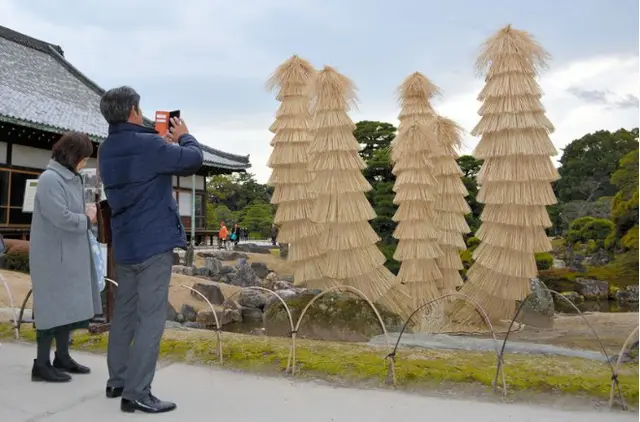Decked out in its distinctive winter coat, a tropical sago palm in the Ninomaru Garden of historic Nijo Castle here is stopping tourists in their tracks.
What, many visitors seem to be asking, is going on? It is simply that gardeners at the UNESCO World Heritage site in the city's Nakagyo Ward want to protect the tree--which, at first glimpse, appears to have four or five limbs--during winter when temperatures hover at around 5 or 6 degrees.
The way of wrapping trees in warm winter straw coats is unique in this garden.
The process involves folding the fronds of the palm against the trunk and wrapping the plant in straw resembling multilayered lampshades.
Come spring, the undressing takes place.
The bigger question is why the sago palm, a species common to southern and more hospitable climes, was planted in Kyoto, and given this elaborate decoration?
The Ninomaru Garden's sole sago palm stands near the northern end of the Ninomaru Palace.
The palm is wrapped in straw every winter, according to officials with the Nijo Castle Office of the Kyoto city government.
The work begins in late November, and the coat remains in place until late March.
This level of tender loving care was already practiced when Nijo Castle was placed under the care of Kyoto city authorities by the now-defunct Imperial Household Ministry in 1939, officials said.
The process begins by raising the fronds upward and binding them to the trunks with rope.
“The important point about it is how smooth the lines look in silhouette,” said Masato Hanawa, 45, one of the Nijo Castle Office's gardeners.
Getting the right "look" involves inserting straw into the wrapping to create an overall picture of a tree decked out in successive layers of lampshades. The process is anything but easy to achieve.
“I learned everything from my seniors on-site,” said Hanawa, adding the knowledge of how to "dress" a sago palm in winter is passed down generation-to-generation as no manual exists that spells out the process.
If it was just a matter of covering the tree in straw matting, the work would take three or four days at most. But the decorative technique takes 15 days to get right, and uses two to three times the amount of straw that would normally be needed.
“This process probably means more than just getting prepared for winter,” said a city government official. “It was probably intended to make visitors realize the high standing of the garden.”
It is also a very practical design.
“It is not only visually aesthetic, but also allows snow to fall to the ground without accumulating,” Hanawa said.
“The work is labor-intensive, and we should not let the skills we have inherited die out in our generation,” Hanawa said.
ORIGIN SHROUDED IN MYSTERY
Still, it is not not known when the sago palm was planted at Nijo Castle.
A photo taken during the rule of Tokugawa Yoshinobu, who was the 15th and last shogun of the Tokugawa family, shows a sago palm standing in exactly the same spot.
Officials of the Nijo Castle Office speculate that the tree must be more than 150 years old.
There is also a written record that states that the Nabeshima feudal domain in today’s Saga Prefecture presented a sago palm as a gift in 1626, during the reign of Iemitsu, the third shogun of the Tokugawa clan, to coincide with Emperor Go-Mizunoo’s visit to Nijo Castle.
It is believed that the Ninomaru Garden was given a partial facelift on that occasion by Kobori Enshu (1579-1647), a famed landscape gardener.
“The ability to bring a sago palm from southern Japan and make sure it took root probably symbolized the power of that time,” said an official with the Nijo Castle Office.
A connecting corridor in the Ninomaru Palace that overlooks the sago palm is called “Sotetsu no Ma,” or the hall of the sago palm.
The name is believed to derive from a cedar-board door painting of a sago palm that was finished to mark the imperial visit. It is now designated as an important cultural property.
However, it remains unknown if a sago palm in the garden was used as a model for the door painting.
(The Asahi Shimbun)
 简体中文
简体中文








